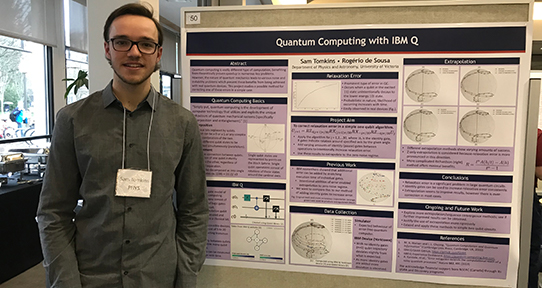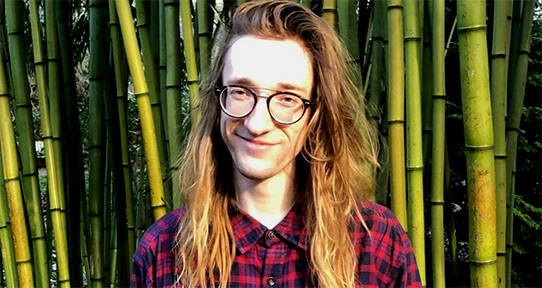Q&A with students Tristan Zaborniak and Sam Tomkins on quantum computing
Last month, UVic students Tristan Zaborniak and Sam Tomkins both presented their Honours thesis research at the prestigious IEEE International Conference on Quantum Computing & Engineering (QCE20).
“Tristan and Sam have integrated their degree with cutting-edge research in one of the most exciting areas of science and engineering: the development of quantum computing hardware and software.”
-Associate Professor and quantum physicist Rogério de Sousa
The research has also resulted in two publications: ‘Benchmarking Hamiltonian Noise in the D-Wave Quantum Annealer,’ coauthored by Zaborniak and ‘Noise mitigation with delay pulses in the IBM Quantum Experience,’ coauthored by Tomkins.

What is quantum computing?
Tristan: Quantum computing is a rapidly–advancing computing paradigm that promises to change the way we think of computers. Whereas the basic unit of information in classical computing is the bit (taking on either 0 or 1), the corresponding basic unit in quantum computing is the quantum bit, or qubit. A qubit is a quantum system which can exist as a superposition of two observable values (0 and 1) prior to observation, with its state determined by the probabilities of its basic values being observed. For example, we can prepare a qubit whose state is such that upon observation there is a 70% chance it will turn up 0, and a 30% chance it will turn up 1.
The properties of qubits allow for certain problems to be solved way faster using quantum computers and their specially-designed algorithms. Last year, Google’s Sycamore processor of 54 qubits solved a problem that would take 3 million times as long to solve using the world’s fastest supercomputer (IBM’s Summit)!
However, a major limitation of current quantum computers is that their qubits suffer from various sources of background noise, which prevents their behaviour from being controlled precisely enough to accurately perform computations, especially on larger scales. If we understand the structure of noise and where it comes from, we are better equipped to silence it and develop more reliable quantum computers. To this end, we both worked on projects to study noise in quantum computers.
How did your research address the issue of background noise in quantum computing?
Tristan: My project sought to characterize the behavior of the noise impacting the D-Wave 2000 qubit quantum computer. The goal was to better understand the sources of noise and their respective importance, a crucial step in engineering solutions to dampen their effects.
This culminated in the development of a technique to extract the noise affecting qubits in one of the two major quantum computing architectures (annealing, the other being gate-model) in the context of their processing unit as opposed to in isolation, lending a tool to assess the performance of this architecture and help identify affective noise sources irrespective of qubit material and processing unit layout.
Sam: My research looked at mitigating noise issues in IBM’s quantum computers. We performed a calculation with a known result on this system. Since the quantum computer was noisy, the result we actually got differed from the “correct answer”. We then started intentionally adding noise to the quantum computer, causing the result to stray even further from the right answer. By observing a trend in how the result changed as we added noise, we were able to predict what the result would have been if we were removing noise.
My project resulted in the development of a knob to tune the amount noise in the IBM quantum computer, which could be useful for other researchers performing more in depth analyses of noise. Secondly, our method to “guess” the noiseless result could be helpful for obtaining useful results from noisy quantum computers until hardware improves.
Both: Our work represents a small step in the huge picture of addressing noise issues in quantum computers and demonstrates the importance that student researchers could play in advancing this field. Both projects were completed entirely using free cloud access to quantum computing systems, demonstrating their ever-increasing accessibility. Our work also reveals that there is a broad range of research opportunities available and necessary for the further development of quantum computing.
What would you like the public to know about quantum computing?
Both: Quantum computing technology isn’t really meant to take over our everyday computers - you probably will never have a quantum iPhone. Instead, the technology will complement classical computing in offering improvements in certain resource-heavy computations, where it is poised to revolutionize chemistry, nanotechnology, and materials research, bolster the capabilities of machine learning, reduce the intensiveness of solving large optimization problems (such as in traffic flow and finance), and improve weather prediction, among a myriad of other applications.
For those interested in learning more and without a physics background, there are aspects of quantum computing that don’t require a strong understanding of quantum mechanics. There are many research and working opportunities for those who come from other academic backgrounds, particularly those in computer science. And of course, it is really, really cool!
How did you get involved in these projects?
Both: We began working with Rogério as summer students through NSERC-USRA positions (Undergraduate Student Research Award). The completion of our term as student researchers lined up with the start of our honours thesis course (Physics 499). These projects led us to continue working with Dr. de Sousa for our honours projects, which ultimately developed into the papers which were included in QCE20.

What was your research experience before starting the USRA last summer?
Tristan: My experience over my undergraduate degree has included a broad range of projects, including in environmental microbiology with Dr. Caren Helbing, species distribution modelling with biologist Dr. Geraldine Allen and nanoelectronics with Dr. Chris Papadopoulos in Electrical and Computer Engineering. Each of these opportunities have variously taken on the forms of work-study, NSERC-USRA, SURA (Student Undergraduate Research Award), or JCURA (Jamie Cassels Undergraduate Research Award).
Sam: An NSERC-USRA with Rogério was my first experience with proper academic research. I was inspired to apply for the position with Rogério after attending Honours Fest, the Faculty of Science’s annual poster presentation session, where I saw my peers and close friends presenting their research. Seeing their hard work and success sparked my interest in gaining research experience and presenting at this year’s Honours Fest.
What advice would you give to students considering pursuing an honours project in Science?
Both: Take advantage of work-study opportunities, consider research-based co-op placements (funding opportunities lying in NSERC-USRAs and UVic SURAs), reach out to professors regarding volunteer positions in their working groups, and look into research experience courses (such as those offered through Biochemistry and Chemistry) and directed studies. These opportunities provide a taste of what is involved in carrying out a full honours research project and of course guide the development of pertinent skills (technical know-how, communication, organization, asking the right questions, perseverance, thinking beyond the box).
Research differs markedly from coursework in its time-scale, depth, and winding nature. Be comfortable with being stumped. Be self-motivated, and intrigued. Be appreciative of the overwhelming volume of research-space and the willingness of professors to engage with students in this way. They’re a fun and supportive bunch.
